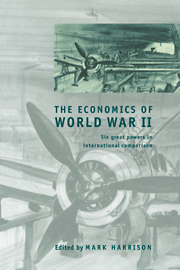Book contents
- Frontmatter
- Contents
- List of figures
- List of tables
- List of contributors
- Preface
- List of abbreviations
- 1 The economics of World War II: an overview
- 2 The United Kingdom: ‘Victory at all costs’
- 3 The United States: from ploughshares to swords
- 4 Germany: guns, butter, and economic miracles
- 5 Italy: how to lose the war and win the peace
- 6 Japan: guns before rice
- 7 The Soviet Union: the defeated victor
- Index
6 - Japan: guns before rice
Published online by Cambridge University Press: 12 September 2009
- Frontmatter
- Contents
- List of figures
- List of tables
- List of contributors
- Preface
- List of abbreviations
- 1 The economics of World War II: an overview
- 2 The United Kingdom: ‘Victory at all costs’
- 3 The United States: from ploughshares to swords
- 4 Germany: guns, butter, and economic miracles
- 5 Italy: how to lose the war and win the peace
- 6 Japan: guns before rice
- 7 The Soviet Union: the defeated victor
- Index
Summary
Introduction: the phases of Japan's war economy
The Japanese invasion of China began with the Manchurian Incident of 1931. However, the Japanese economy at the time of the incident was still recovering from the slump which began in 1929. It is only with the Marco Polo Bridge Incident in 1937 and the outbreak of full-scale hostilities between China and Japan that the Japanese economy shifted to a wartime basis. In political or military history, the fifteen-year period between 1931 and defeat at the hands of the Allies in 1945 was one of continuing warfare, but in economic history this applies only to the period after 1937. The years 1932–6 saw little military influence on the economy, which may thus be considered to be basically a peacetime one. The 1934–6 average, being the peacetime peak before Japan commenced aggressive action in earnest, was taken by the Allies as the prewar standard for Japanese postwar recovery, a practice which I shall follow below as far as possible.
From the inception of the wartime economy in 1937 until the freezing of Japanese foreign assets in 1941, overseas trade remained feasible for Japan, but trade was increasingly controlled by regulatory measures designed to ensure the effective use of scarce foreign currency for wartime objectives. After the freezing of assets and the declaration of war on America, Britain, and the Netherlands in 1941, and during the ensuing period of the Pacific War, there was a shift from the control of foreign currency to the control of shipping.
- Type
- Chapter
- Information
- The Economics of World War IISix Great Powers in International Comparison, pp. 224 - 267Publisher: Cambridge University PressPrint publication year: 1998
- 8
- Cited by



